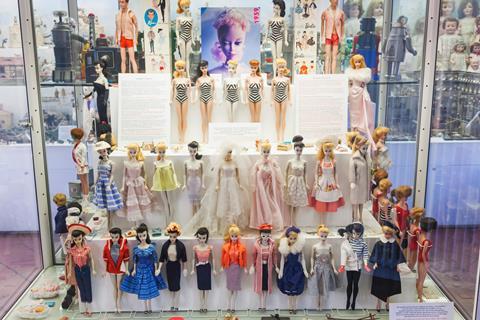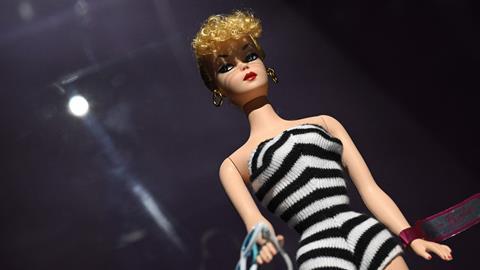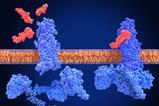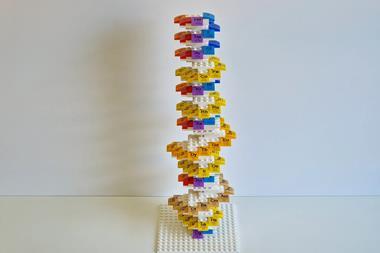Although she is a cultural icon, conserving Barbie has its challenges: as with most plastic toys and dolls, she was not made to last. Rachel Brazil investigates how conservation scientists are approaching this sticky problem
Some love Barbie for being a pioneering female role model, with astronaut and surgeon dolls available before these careers were attainable for woman in real life. Others deride her for her permanent high heels and unrealistic body shape, which some worry add to the body image anxiety experienced by many young girls. Either way, Barbie’s status as a cultural icon has made her collectible – the oldest and rarest dolls now fetch over $1000 (£800). But keeping her for posterity is not so easy – as with most plastics, Barbie was not made to last. She suffers from what conservators call ‘inherent vice’ – an instability intrinsic to the plastic she is made from.
Efforts to conserve Barbie dolls are sometimes met with derision and the sentiment ‘Why are you putting all this effort into this girl’s toy?’ according to Odile Madden, a materials scientist and conservator who is currently at the Smithsonian National Museum of Natural History in Washington DC, US. As a former little girl herself, she takes preserving Barbie’s legacy very seriously. ‘Barbie is economically important, Barbie is commercially important, Barbie is culturally important … Barbie is a billion dollar industry.’
Sticky legs and green ears
But Barbie does not always age well. One of her most common afflictions is known as ‘sticky leg syndrome’. This refers to sticky deposits or white blooms appearing on the doll, very often but not exclusively on the legs. ‘The vast majority of conservators asked will have seen sticky surfaces … certainly in the older samples [from the] 50s and 60s,’ says Rose King, who recently joined the Metropolitan Museum in New York, US, after completing her PhD in plastics degradation at UCL in the UK.

This kind of deterioration was seen in Barbie dolls from a private collector that were studied by Andrea Macchia from the University of Calabria in Italy and colleagues from the Youth in Conservation of Cultural Heritage network. They studied 16 dolls dated from 1959 to 1976. Conservation scientist Francesca Izzo at Università Ca’ Foscari in Venice, Italy, was also part of the team and has more recently been studying her own childhood Barbies from the 1980s to compare the compositions to older dolls (a study she has not yet published).
King also saw this type of problem as part of a team examining dolls from an art installation currently on loan to the Tate Gallery. In ‘Mouth Open, Teeth Showing 2000’, US artist Zoe Leonard arranged 162 children’s plastic dolls, collected from flea markets in the late 1990s, standing upright in a grid – it is a striking and slightly disturbing image, which attempts to provide insights into changing fashions, gender roles and representation over time.
One of the reasons for using PVC is that it is an excellent skin mimic
For King and the other conservation scientists the priority is to analyse non-destructively, so as not to damage culturally important material. One favourite technique is Fourier transform infra-red spectroscopy in attenuated total reflectance mode, where the IR light passes through a crystal, often diamond. The internally reflected light spills over into the sample in close contact with the crystal before being detected. ‘One of the [additional methods] I started to work on was just swab sampling and doing some form of thin layer chromatography … although if you’re requiring solvent, then most people would prefer not to use it,’ says King.
A simple analytical technique Izzo and many conservators use is UV-induced fluorescence, which can easily detect PVC, the most common plastic used in early Barbie dolls, from its dim green fluorescence emission. ‘One of the reasons for using PVC, especially on the face, arms and legs of Barbie and other dolls, is that PVC is an excellent skin mimic – there aren’t really other plastics that have that texture,’ says conservation scientist Yvonne Shashoua from the National Museum of Denmark in Copenhagen, who specialises in understanding plastic degradation.
Plasticiser peril
When PVC forms from vinyl chloride monomers its chains tend to line up due to electrostatic interactions, creating a rigid, almost crystalline arrangement. ‘If you can get smaller molecules to fit in between and undermine those inner chain attractions just enough, you can create a plastic that is flexible, but still solid at room temperature,’ explains Madden. Shashoua describes the small molecules known as plasticisers as equivalent to fabric softeners, although they do not coat the polymer uniformly but find the less crystalline amorphous areas within the PVC structure – enough to create a flexible polymer.
Around 30 to 40% of plasticiser by weight was typically needed and from early in plastics history phthalate esters became the go-to molecules. ‘[They] started off as plasticisers for cellulose acetate [plastics], and were rolled into being used for PVC.’ says King. ‘You can quite easily change the branching or the length of the alcohol chain to change its properties.’ Dioctyl phthalate or di(2-ethylhexyl) phthalate are commonly found in older Barbies, although both these compounds are now banned from toys in the EU and US due to their endocrine-disrupting properties.
Over time these materials are not stable. ‘The plasticiser is freely moving around between the polymer chains and that means that it can freely come out again by a process of diffusion,’ says Shashoua. Depending on the phthalate used, it may evaporate, leading to a diffusion gradient and further plasticiser loss or leave a sticky deposit. The sticky deposits detected by Izzo and King are both linked to plasticiser loss. The white deposit on one of the dolls from the Leonard installation included cyclopentanone, which the team suggested was a product of the breakdown of hexanedioic acid, whose ester was also used as a plasticiser.
As the degradation progresses PVC will also become more brittle and may even shrink once more than 15% of the plasticiser is lost – although this isn’t noticeable on most Barbie dolls. Changes can also start occurring to the polymer itself which can photo-oxidise, leading to conjugation and cross-linking of polymer chains and causing darkening. Shashoua has worked on a PVC doll from the 1970s which after 50 years is showing only browning on the arms, face and below the knees; ‘That’s because she had a dress on that protected her from both the evaporation of plasticiser and sunlight,’ she says.
Over the years poor Barbie can also suffer from ‘green ear syndrome’, green streaking often around the doll’s ears or even across her face. This stems from the hydrogen chloride released as the polymer is itself oxidised. ‘Phthalate plasticisers also work as antioxidants for the PVC polymer,’ says Shashoua, but ‘as you lose more and more plasticiser we begin to see the production of hydrogen chloride.’ Any copper present – say in an earring – starts to corrode, leaving streaks of copper chloride which have become mobilised by the diffusing plasticiser.
Investigating further
In 2017 when Madden was at the Smithsonian Museum Conservation Institute she was asked to help diagnose a Barbie with a more unusual condition. From a private collection in Los Angeles, the doll was a 1960 #4 Barbie, one of the first models, complete with the now familiar black and white swimming costume. The doll had a handwritten ink signature by Mattel co-founder Ruth Handler – now fuzzy due to ink migration within the plastic doll’s back.
The conundrum was brought to Madden in Washington by then UCLA graduate students Marcy Burton and Morgan Burgess, both now professional conservators. ‘[The Barbie] had fuzzy legs – they had this white crystalline efflorescence on them,’ says Madden. But analysis of the recurring white bloom showed this was not conventional sticky leg syndrome. ‘We put her on the ATR crystal of our FTIR spectrometer, we took off her shoe, and we pushed her foot down on to it and analysed her that way and found that the legs were PVC,’ explains Madden. They also identified the plasticiser as di(2-ethylhexyl) phthalate, which is a liquid at room temperature so a fuzzy crystal surface layer didn’t make sense.
Further analysis of the crystals using dispersive Raman spectroscopy identified the fuzz as a stearate (an 18-carbon carboxylate), probably sodium stearate. ‘Then the question was why is the stearate there?’ asks Madden. Stearic acid and other stearates are known lubricants to facilitate moulding PVC by stopping the liquid plastic sticking to the mould and improving flow.
When you think about how unrealistic those legs are, I just find it ironic that they are also are the root of this Barbie’s problems!
The team also looked at the doll and another 1963 doll with x-ray computed tomography (CT) to compare the structures and noted bubbles in the PVC making up the legs. They started thinking about Barbie’s shape and those very long and oft-criticised legs – which represent more than half her height. Some have suggested Barbie’s proportions are so unrealistic they would make her unable to support her own weight.
Madden thought the bubbles could indicate that during moulding the hot liquid plastic was beginning to cool and set before reaching the toes at the end of the mould. Might the stearates have been added to try and prevent this premature cooling and allow the PVC to reach the end of the mould with fewer bubbles or irregularities?
‘We came down to the idea that the stearates were facilitating those long legs,’ says Madden. Given the early date of the doll they wondered if this represented an early solution because the exuding of the lubricant is not seen across all Barbies and later structures seem to have been redesigned, with for example hollow thighs. ‘When you think about how unrealistic those legs are, and how much fear there has been about girls’ self-image and self-esteem [because of] those legs, ‘says Madden, ‘I just find it ironic [that they are] also are the root of this Barbie’s problems!’
Conservation solutions
For conservators the dilemma is now how to deal with sticky legs and other body parts. As the stearates were not serving a purpose in the final object Maddens team felt removing the fluff did not pose an ongoing risk to the doll. But removing plasticisers is not as straightforward. ‘There are two schools of thought,’ says Dublin-based conservation scientist Brenda Keneghan, now retired from the Victoria & Albert Museum in London, UK. ‘One school of thought is that you just leave it and you keep it in an enclosed area so that dust and dirt doesn’t settle on [it]. The other school of thought is that you do remove the plasticiser, with the knowledge that more is going to come over the years.’
Conservation ethics would also caution against removing part of a material that is fundamental to its composition, on top of the risk of allowing further plasticiser to diffuse out of the plastic. ‘Removing the stickiness is something to be thought about carefully,’ says Madden, although she concedes, ‘stickiness attracts dust, so in the real world, what are your options?’

Shashoua agrees that aesthetic decisions are often made. She had a similar problem with another collectible – the troll doll, originally carved from wood by furniture maker Thomas Dam, but by the 1950s becoming a Danish export, made from PVC. Older collectible troll dolls also experience plasticiser loss. If deposited on the surface, phthalate esters can sometimes react with moisture to form phthalic acid or its cyclic anhydride, both of which do form white crystals. ‘They give the troll the image of having psoriasis skin disease,’ says Shashoua. She would remove the water-soluble crystals soluble but says it’s generally done at a low temperature (around 50°C) to try and minimise further plasticiser loss.
Other than cleaning, conservators have little else to remedy the degradation of PVC. ‘There have been some ideas of coating, but they haven’t really been successful,’ says Shashoua. Coatings need to adhere well to the surface, which is usually facilitated by a solvent and PVC is resistant to solvents. ‘That’s one of the benefits of it and for that reason it’s very difficult to etch to get a coating to stick on to it.’
There’s a growing acceptance that some plastic objects cannot be saved
What’s left is to try and limit further damage by carefully controlling the environment in which Barbie and other dolls are stored. ‘UV light is the big the big enemy of plastics, because it contains enough energy to break the bonds, so you would always have UV filters in galleries and in stores,’ says Keneghan. Low temperature storage is another option, to slow down the diffusion of plasticisers, but apart from cost issue this can also encourage the formation of the sorts of stearate lubricant blooms Madden’s team encountered. A 2017 study of more than 130 Danish PVC dolls from the 1980s and 90s, stored for 10 years in a climate-controlled facility at 11–12°C showed white blooms of 1-octadecanol (stearyl alcohol) were present on the surface which were reabsorbed after one month storage at room temperature.
Storing plastics in sealed containers is another option to reduce the migration rate of plasticisers but including absorbent materials that remove oxygen or moisture could be problematic in also drawing out more plasticiser. King says the Metropolitan Museum of Art in New York is currently trialling anoxic storage environments by filling storage bags with inert gases.
With the arrays of different plastics museums are now seeking to conserve, ‘there’s no one size fits all approach’, King says, but ‘there’s a growing acceptance that some [plastic] objects cannot be “saved”’.
Not indestructible
It’s ironic that today we think of plastic as almost indestructible and a danger to the environment but in reality many plastic objects are unstable, an idea captured in the term ‘inherent vice’, coined by conservators to describe materials whose intrinsic make-up will inevitably lead to self-destruction. While this is starting to be seen in many of the early PVC Barbie dolls, some older plastics like cellulose nitrate degrade in an even more dramatic fashion, even spontaneously combusting.
‘All materials are unstable,’ conceeds Shashoua, ‘[but] plastics have an incredibly short lifetime compared with metals and stone, and even textile or cotton.’ For the makers of Barbie, longevity was never a major concern. ‘Plastics were never really considered to be made for long term. If your Barbie doll or your shower curtain falls apart, you just buy a new one,’ says Keneghan. Izzo agrees, ‘Barbies were not supposed to be in museums, they were supposed to be used by children.’
Which is not to say that manufacturer Mattel have not innovated in the plastics they use since Barbie arrived in 1959. From their analysis of 16 Barbie dolls Izzo and her collaborators found that by the 1970s Barbie’s torso had shifted from PVC through low density polyethylene to acrylonitrile butadiene styrene (ABS) – the plastic also used for Lego bricks. Today the arms are made from more flexible ethylene–vinyl acetate and durable polypropylene is used for Barbie’s bendy joints. But her long legs and head are still made from PVC, albeit with less toxic plasticisers.
Shashoua is now using her knowledge of polymer degradation to study the persistence of plastics in the environment. ‘If you google “How long do plastics last?” you get an an array of numbers. For example with PVC and you’d see something from one year to thousands of years,’ she says. Given her experience of examining degrading plastics in museum collections she is sceptical of these estimates. In the last four years she has been carrying out some real-time standardised ageing experiments on single use plastic cups and cutlery. She has left samples exposed in underwater sediments and at the surface and is analysing what comes off the plastics and the change in their chemical structure.
As Shashoua’s experience would suggest, the samples on the surface exposed to UV light from the sun break down much more quickly than those in other environments. But she has also been surprised at just how quickly this happens. ‘I would say that we could half the estimates [of] how long we think it takes for plastic cups to degrade…it’s a matter of single years, rather than tens or hundreds of years,’ she concludes. So the future of those historic Barbies from the 1950s and 60s will depend on how successfully conservators can hold back the inevitable.
(And while they are doing that, one final question comes to mind – is anyone keeping an eye on Ken?)
Rachel Brazil is a science writer based in London, UK





















1 Reader's comment